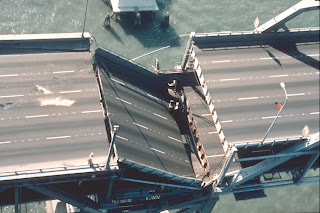The Bay Area is known for its complex and diverse terrain and landforms. The region is made up of mountains, hills, valleys, low lands, marshes, and large bodies of water. The highest point in the Bay Area is Mt. Hamilton at 4,360 feet. The largest body of water is the San Francisco bay measuring 3 to 12 miles wide east-to-west and somewhere between 48 miles and 60 miles north-to-south. It is the largest pacific estuary in the Americas and drains around forty percent of water from California including from the San Joaquin and Sacramento rivers and the Sierra Nevadas. There are five islands in the San Francisco bay, Yerba Buena island, Angel island, Alameda island, Alcatraz island, and Mare island. Angel island is known as Ellis island of the west because it served as an entry point for immigrants from Asia. Alcatraz island is home to the famous federal penitentiary that is now a popular tourist attraction. The entrance to the bay from the Pacific Ocean is called the Golden Gate and is spanned by the Golden Gate bridge.

The diverse terrain of the Bay Area has been created from millions of years of plate tectonics. The biggest fault running underneath the Bay Area is the San Andreas fault, however there are hundreds of sister faults also running through the region. Because of these fault lines the Bay Area, like most of California, is very susceptible to earthquakes. For example, the 1906 San Francisco earthquake that registered a 7.8 magnitude, killed over 3,000 people, and destroyed over 80% of San Francisco. More recently, the 1989 Loma Prieta earthquake, also known as the World Series earthquake because it occurred during warmups before the Oakland A's and San Francisco Giants squared off in game three. That quake registered a 6.9 magnitude and damaged infrastructure throughout the Bay Area including collapsing the upper deck of the Bay Bridge.
The Bay Area is known for its microclimates due to the differences in terrain and proximity to water. Areas near the water including the coast and the bay, experience small temperature variations, cool foggy summers, and mild rainy winters. Inland regions experience hotter days and colder nights. The South Bay averages 15 inches of rain a year, while the North Bay averages over 30 inches. Snow falls on the higher elevations including Mt. Hamilton, Mt. Tamalpais, and Mt. Diablo. They say in the Bay Area if you want a change in temperature, just go over the hill!




I really like your commitment to the Bay Area, if you are not already from there, I would be inclined to think that you are from the bay area becuase you were able to connect some aspect of the city you covered to every chapter in the book. Besides, the baseball video of the A's and Dodgers during the 1988 World Series was classic.
ReplyDelete